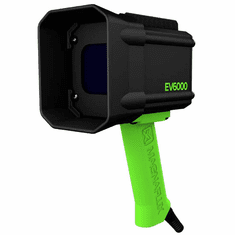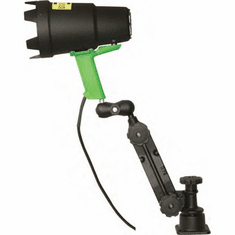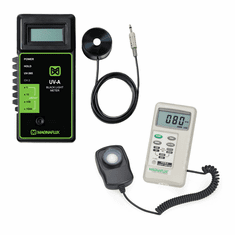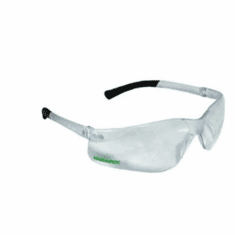Collection: UV LED Lamps
-

Portable NDT Black Lights
Magnaflux NDT Black LightsEV6000 UV Lamp Aerospace CertifiedAn industrial black light designed...
-

Blacklight Mounting Systems
Magnaflux UV lamp and black light mounting hardware and accessories allow stabilized,...
-

Magnaflux NDT Light Meters
NDT Light Meters For Fluorescent NDT Inspection Our non-destructive testing light meters...
-

UV Safety Glasses
Protect your eyes in style with our comprehensive collection of UV safety...
UV Lamp Buying Guide
Introduction
UV lamps, also known as black lights, are essential tools for non-destructive testing (NDT), particularly in fluorescent magnetic particle testing (MT) and liquid penetrant inspection (PT). This buying guide will help you select the right UV lamp for your specific NDT needs, drawing from Magnaflux's expertise in the field.
Understanding UV-A Requirements
For NDT applications, UV-A is electromagnetic radiation in the near-ultraviolet range with peak intensity at 365 nm (3650 Å). All fluorescent penetrants and magnetic particle materials are designed to fluoresce optimally at this wavelength, making it the industry standard for nondestructive testing.
Key Factors to Consider
1. Peak Wavelength & Emission Spectrum
Critical Requirements:
- Peak wavelength must be within 360-370 nm range
- Original mercury-vapor lamps produced a single UV-A peak at 365.4 nm
- All fluorescent materials are tuned to fluoresce under UV-A at 365 nm
LED Considerations (EV6000 & EV6500 Examples):
- The EV6000 features custom-designed optics that provide intense and even UV-A coverage with an integrated filter ensuring minimal visible light emission
- Both models feature uniform beams with no hot-spots
- Peak wavelength varies depending on individual LEDs used
- For aerospace specifications (ASTM E3022, Nadcap AC7114, Rolls-Royce RRES 90061), UV-A pass filters are required to block visible emission
2. Beam Profile & Working Distance
Beam Area (Real-World Examples):
- EV6000: 9 in / 23 cm wide beam, 33% wider than the next widest hand-held UV lamp in the industry
- EV6500: 10 in / 25 cm wide beam, the widest coverage area in its class
- Small beam area: Good for tight spaces (holes, weld joints, internal surfaces)
- Large beam area: Better for large structures, prevents "tunnel vision"
- Wide beam allows inspection of peripheral areas and clearly visible indications even at beam edges
Working Distance:
- EV6000: Maximum irradiance of 5,000 μW/cm² at 15 in / 38 cm
- EV6500: 7,000 μW/cm² high intensity UV-A illumination
- Minimum distance required for even coverage
- Too close: Individual LEDs create separate beams with dim areas
- Proper distance: LEDs merge into smooth, even profile
- Always position lamp farther than minimum working distance
Trade-offs:
- Close inspection = focused intense spot but small beam area
- Wide coverage = requires LED array but needs proper working distance
3. Certification Requirements
Aerospace Industry:
- ASTM E3022 certification required
- Meets Nadcap audit criteria
- Acceptable for all aerospace primes and OEMs
- Required for final aerospace inspection
- Not required for process stations (wash/rinse)
Industrial Applications:
- Fewer certification requirements
- More rugged conditions require intense UV-A
- Certificate of conformance should include:
- Maximum UV-A intensity (regulated below 10,000 µW/cm²)
- Peak wavelength within 360-370 nm range
- Research shows intensities above 10,000 µW/cm² at 15 inches can cause fluorescent dye fading
Magnaflux UV Lamp Models & Applications
EV6000 - Aerospace-Certified LED UV Lamp
Ideal for: Aerospace applications, precision inspections, portability requirements
Key Features:
- 5,000 μW/cm² maximum irradiance at 15 in / 38 cm
- 9 in / 23 cm wide, uniform circular beam - 33% wider than the next widest hand-held UV lamp in the industry
- Lightweight at only 2.8 lbs / 1.3 kg
- IP65 rated, rugged, durable design
- Certified to ASTM / RRES / NADCAP
Benefits:
- Minimizes Inspection Time: Speeds up inspection time with one of the widest, most even beams on the market
- Enhanced Visibility: Indications are clearly visible even at the edge of the 9 inch / 23 cm beam
- Improved Reliability: Reduces on-the-job downtime with dependable, reinforced construction
- Environmental Durability: Fully sealed IP65 rated housing will stand up to the elements, along with a fan-less cooling system and non-clouding lens
- Operator Safety: Compact, lightweight, easy-to-hold design weighs in a full 30% less than mercury-vapor UV lamps, reducing stress and fatigue
EV6500 - High-Intensity Dual-Light LED UV Lamp
Ideal for: High-intensity inspections, industrial applications, versatile field work
Key Features:
- 7,000 μW/cm² high intensity UV-A illumination
- 10 in / 25 cm wide, uniform beam - the widest coverage area in its class
- Built-in LED white light providing over 150 ft-candles
- Single push-button operation for UV and white light
- Rugged, durable design with no internal fan
Benefits:
- Faster Inspections: Decrease inspection time by improving indication visibility with high intensity UV-A illumination
- Enhanced Versatility: Easy-on visible light LEDs for visible flaw location, eliminating the need for a separate flashlight
- Broad Coverage: Designed with broad-beam profile for in-line and hand-held use
- Operational Efficiency: Single-button operation switches between UV and white light modes
Comparison Summary
| Feature | EV6000 | EV6500 |
|---|---|---|
| Intensity | 5,000 μW/cm² | 7,000 μW/cm² |
| Beam Width | 9 in / 23 cm | 10 in / 25 cm |
| Weight | 2.8 lbs / 1.3 kg | 2.8 lbs / 1.3 kg |
| Certification | ASTM/RRES/NADCAP | Industrial grade |
| Dual Light | UV only | UV + White light |
| Best For | Aerospace applications | High-intensity industrial work |
Modern LED Advantages
Sustainability Benefits:
- No mercury content (unlike traditional mercury-vapor lamps)
- Longer lifespan
- Lower environmental impact
- Regulatory compliance as mercury exemptions expire
Performance Benefits:
- Greater design flexibility
- Improved safety
- Variable configurations for specific applications
- Better portability
Pre-Purchase Checklist
Before investing in a UV lamp, evaluate:
-
Industry Requirements
- Aerospace: ASTM E3022 certification needed
- Industrial: Certificate of conformance sufficient
-
Application Needs
- Working distance requirements
- Beam area needed
- Portability requirements
-
Technical Specifications
- Peak wavelength (360-370 nm)
- Minimum intensity (1,000 µW/cm²)
- Maximum intensity (below 10,000 µW/cm²)
- Filter requirements for visible light
-
Power Requirements
- Battery life needs
- Constant-current protection
- Charging capabilities
-
Accessories
- Light meters for intensity measurement
- Filters for aerospace compliance
- Carrying cases and mounting options
Maintenance and Calibration
Regular Monitoring:
- Use light meters to verify UV-A intensity
- Check for visible light contamination
- Monitor battery performance
- Verify working distance compliance
Documentation:
- Maintain calibration records
- Track lamp performance over time
- Record intensity measurements
- Document any performance degradation
Conclusion
Selecting the right UV lamp requires careful consideration of your specific NDT requirements, industry standards, and application needs. LED technology offers significant advantages over traditional mercury-vapor lamps, including improved safety, sustainability, and flexibility. By understanding the key factors outlined in this guide and matching them to your specific requirements, you can ensure optimal performance for your fluorescent penetrant testing and magnetic particle inspections.
Remember that while LED lamps provide greater flexibility, they also require more detailed specifications to ensure proper performance. When in doubt, consult with NDT professionals and consider lamps that meet or exceed industry standards for your specific applications.




